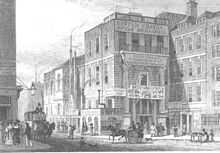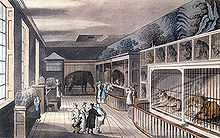Exeter Exchange

The Exeter Exchange (popularly known as Exeter Change) was a building on the north side of the Strand in London, with an arcade extending partway across the carriageway. It is most famous for the menagerie that occupied its upper floors for over 50 years, from 1773 until it was demolished in 1829.
Exeter Exchange was built in 1676, on the site of the demolished Exeter House (formerly Burghley House and Cecil House), London residence of the Earls of Exeter, almost opposite the Savoy. Around the same time, the nearby Burleigh Street and Exeter Street were laid out. The Exeter Exchange originally housed small shops (milliners, drapers, hosiers) on the ground floor, and rooms above which were let to the Land Bank. Over time, the traders on the ground floor were replaced by offices, and the upper rooms were used for storage.

From 1773, the upper rooms were let to a series of impresarios who operated a menagerie in competition with the Royal Menagerie at the Tower of London. The menagerie at the Exeter Exchange at various times included lions, tigers, monkeys, and other exotic species, all confined in iron cages in small rooms. The roaring of the big cats could be heard in the street below, occasionally scaring horses that passed by. The menagerie was established by Thomas Clark but was purchased in 1793 by Gilbert Pidcock. It subsequently passed into the ownership of Stephani Polito. Both Pidcock and Polito were operators of travelling circuses, who used the Exeter Exchange as winter quarters for their animals. The menagerie was a popular visitor attraction. It was visited by Wordsworth and Byron; artists such as Edwin Landseer and Jacques-Laurent Agasse painted the animals.
Polito died in 1814, and the menagerie was acquired by one of his former employees, Edward Cross. Cross renamed the collection the Royal Grand National Menagerie, and employed a doorkeeper who was dressed as a Yeoman of the Guard. His bad-tempered elephant, Chunee, was shot there in March 1826 by soldiers from Somerset House. When the Exeter Exchange was demolished in 1829, as part of general improvements to the Strand, the animals were dispersed to the new London Zoo in Regent's Park and Cross's new enterprise at Surrey Zoological Gardens.
Exeter Hall was built on the site, opening in 1831 and surviving until 1907. The site is now occupied by the Strand Palace Hotel.

References
External links
- History of Covent Garden, In And Around Covent Garden, 2004.
- Destruction of a Furious Elephant (Lithographic print, 6 March 1826)
- Destruction of the Noble Elephant (Hand-coloured print, c.1826)
- The Exeter Exchange, The Strand, London
Coordinates: 51°30′40″N 0°07′16″W / 51.511°N 0.121°W